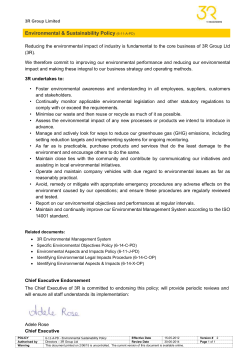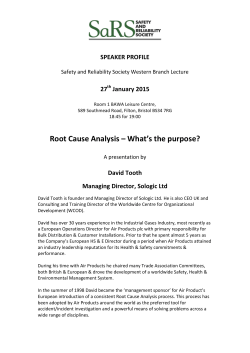
Environmental Impacts of Farming
Environmental Impacts of Farming These icons indicate that teacher’s notes or useful web addresses are available in the Notes Page. This icon indicates the slide contains activities created in Flash. These activities are not editable. For more detailed instructions, see the Getting Started presentation. 11 of of 18 18 © Boardworks Ltd 2006 Learning objectives How does the use of chemicals affect the environment? Other environmental issues in farming. 2 of 18 © Boardworks Ltd 2006 How has food production been increased? The use of mineral fertilizers and pesticides have vastly increased global agricultural yields. Globally, over a hundred million tonnes of artificial fertilizers and pesticides are used every year. 3 of 18 © Boardworks Ltd 2006 Fertilizers What are artificial (or mineral) fertilizers? Fertilizers generally encourage plant growth. They come in salt or liquid form and are mixed with water so that plants can absorb them as a weak solution. Artificial fertilizers are specifically designed for a particular crop. For example, a plant grown mainly for its leaves will need a fertilizer with a high nitrogen content. Farmers spray about 150-200 kg of fertilizer onto every hectare of cereal crop. This can be washed into rivers and lakes causing eutrophication. 4 of 18 © Boardworks Ltd 2006 Eutrophication 5 of 18 © Boardworks Ltd 2006 Eutrophication 6 of 18 © Boardworks Ltd 2006 Pesticides What are pesticides? A pesticide is a substance used to prevent, destroy or repel a pest. The pests you want to control could be insects, mice and other animals, weeds, fungi or micro-organisms (bacteria or viruses). Insecticides kill insects Herbicides kill plants Fungicides kill fungi (mildews, molds, etc.) 7 of 18 © Boardworks Ltd 2006 Problems with pesticides One problem with pesticides it that they can poison wildlife. This is because pesticides accumulate along the food chain. Corn is sprayed with pesticide. Each shrew eats lots of caterpillars, so the poison accumulates in their bodies. Each owl eats lots of shrews, so they get an even higher dose. 8 of 18 The pesticide is transferred to caterpillars on the corn. Pesticides cause owls to produces weak eggs that break easily. © Boardworks Ltd 2006 Other problems with fertilizers and pesticides Producing artificial fertilizers uses fossil fuels. Energy is also used by the machinery spraying the pesticides. Today, it takes about 1.2 barrels of oil to produce a single tonne of grain in more developed countries. This is some 7 times greater than in 1950! Artificial fertilizers and pesticides can also end up in our water supply. It costs Britain £121 million each year to monitor and remove pesticides from the water. 9 of 18 © Boardworks Ltd 2006 Types of pesticide 10 of 18 © Boardworks Ltd 2006 Learning objectives How does the use of chemicals affect the environment? Other environmental issues in farming. 11 of 18 © Boardworks Ltd 2006 Destruction of habitat Agriculture causes the destruction of important habitats for wildlife. Since 1949, the UK has lost: 95% of its lowland grassland 40% of its lowland heaths on acid soils 30-50% of its ancient lowland woods… …and 1949-1974, 140,000 miles of its hedgerows. 12 of 18 © Boardworks Ltd 2006 Hedgerows Why are hedgerows important? They provide a habitat for animals and birds. They reduce soil erosion. They act as windshields, stopping the wind from blowing away the topsoil. The roots of the hedgerows also help by binding the soil together. 13 of 18 © Boardworks Ltd 2006 The effect of hedgerows on soil erosion 14 of 18 © Boardworks Ltd 2006 Genetically Modified (GM) foods What are genetically modified (GM) foods? All organisms have genes. Genes contain a sort of code that tells each organism how to develop. GM crops have had their genes altered by scientists. Some farm animals and crops have been ‘genetically modified’ for centuries using selective breeding. Pedigree cows have been selectively bred. However, modern genetic engineering allows scientists to mix genes from plants and animals that would never normally be able to breed together. For example, a gene from a fish could be put into a tomato. 15 of 18 © Boardworks Ltd 2006 The argument for GM foods Better crops are needed to feed the world’s rapidly growing population. Crops can be engineered to last longer after harvesting, so less food will be wasted. GM crops can be made that don’t need as much water or fertilizer, so droughts would no longer cause famine. 16 of 18 GM crops are more resistant to insects and diseases, so farmers won’t need to use as much insecticide. Crops can be engineered to give health benefits. ‘Golden Rice’ has been engineered to contain large quantities of vitamin A. © Boardworks Ltd 2006 The argument against GM foods We can’t predict what effects GM crops could have on human health. GM crops could spread uncontrolled through cross-pollination. Wild plants and nonGM crops could be pollinated by nearby GM crops. GM crops are resistant to herbicides, so stronger weedkillers can be used – this could wipe out many wild plants. We don’t need GM. There’s enough food in the world for everyone, it’s just that many people can’t afford to buy it. Bio-tech businesses would control agriculture. They can make plants that produce barren seeds, forcing farmers to buy new seeds every year. 17 of 18 © Boardworks Ltd 2006 Plenary 18 of 18 © Boardworks Ltd 2006
© Copyright 2025












